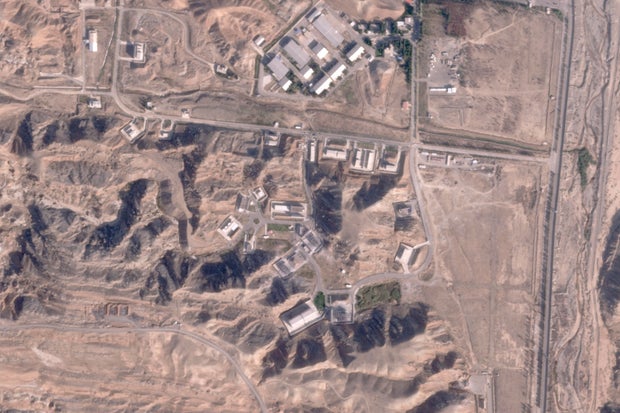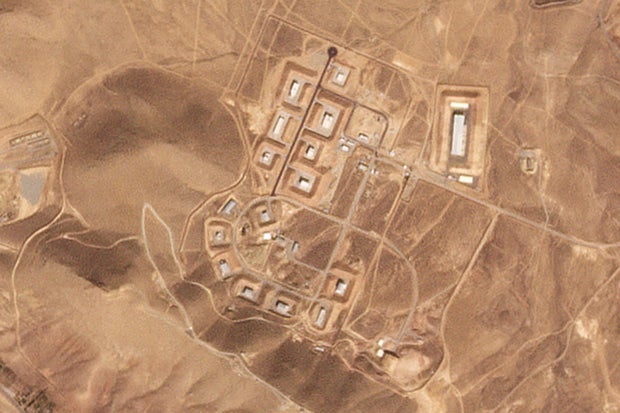CBS News
Once-resistant rural court officials begin to embrace medications to treat addiction

DANDRIDGE, Tenn. — Rachel Solomon and judges hadn’t been on the best of terms. Then Judge O. Duane Slone “dumbfounded” her.
Solomon was given her first Percocet at age 12 by a family member with a medicine cabinet full. It made her feel numb, she said. “Nothing hurt.” By 17, she was taking 80-milligram OxyContins. A decade later, she was introduced to heroin.
During those years, Solomon was in and out of trouble with the law.
Then, five years ago, at 32, she arrived in Slone’s courtroom, pregnant, fearing the worst. But the state circuit court judge saw promise. He ruled that Solomon would serve jail time for an outstanding warrant for aggravated burglary and then would be placed in a program for pregnant or parenting women recovering from addiction. She would retain custody of her son, Brantley, now 4.
Slone also offered an option that many judges, particularly in rural jurisdictions, at that time were averse to extending: medication for opioid use disorder, or MOUD.
A study conducted a decade ago found that barely half of drug treatment courts offered medication treatment. Those that didn’t cited uncertainty about its efficacy and noted political, judicial, and administrative opposition. But research in the years since has persuaded many of the most insistent abstinence-only advocates.
According to Monica Christofferson, director of treatment court programs at the Center for Justice Innovation, amid an accelerating opioid crisis there has been a “huge shift” among judges, prosecutors, and law enforcement agencies away from the stigma associated with medication treatment. Simply put, “MOUD works,” Christofferson asserted.
By 2022, more than 90% of drug courts located in communities with high opioid mortality rates that responded to a survey said they allow buprenorphine and/or methadone, the medications most commonly used to treat addiction. The study also found that 65% of drug court program staffers have received training in medication for treatment, and a similar share have arranged for clients to continue receiving medications while serving jail time for program violations. Still, almost 1 in 4 programs told researchers they overrule medication decisions.
Federal legislation has lowered the barriers to it. And Bureau of Justice Assistance funding for treatment-court programs now mandates that medication for substance use disorder be provided.
Joe Raedle / Getty Images
Solomon experienced that shift in real time in Slone’s courtroom as the judge allowed her access to medication to treat her addiction to opioids.
As a young prosecutor in the 1990s in mostly rural eastern Tennessee, Slone was embedded with a drug task force and was well versed in efforts to counteract the supply side of the opioid crisis. Then, as a circuit court judge, he’d put his share of people behind bars on drug-related convictions.
As the crisis deepened, he started to wonder if addressing the demand side would be more effective.
Like so many other prosecutors and judges, Slone believed abstinence was the only path to recovery. But in 2013, after consulting with substance use disorder experts, he relented, introducing medication as an alternative to incarceration for pregnant women. By 2016, he had fully embraced it throughout his recovery courts — even as most judges, he said, “still believed that it was substituting one drug for another.”
Building from evidence-based research, Slone has launched programs that show how a judge, and a region, can trade an abstinence-only, lock-’em-up approach for one that offers a full range of paths to recovery.
Before witnessing medication treatment’s efficacy, Slone said, he would tell a defendant charged with a drug offense, “‘This is your second chance. If you violate the conditions of your probation, I’m going to put you in jail.'”
Often, six months later they’d be back in his courtroom, charged with a low-level crime and having tested positive for drugs. “They’re 19, maybe 20 years old, and I’m executing a five-year sentence. It makes me sick to my stomach now.”
Slone was sure there must be a better way.
A drug recovery court, which he co-founded in his 4th Judicial District in 2009, was a first step. It allows defendants with nonviolent drug-related charges to avoid jail time by entering treatment and counseling. They’re closely monitored by a team that includes a judge, case manager, public defender, prosecutor, and probation officer. If the participant violates the terms of the agreement, the first step is a reassessment of treatment needs. Multiple violations may result in incarceration.
Because this form of drug court is resource-intensive, relatively few people can be enrolled. So in 2013, Slone introduced the Tennessee Recovery Oriented Compliance Strategy, or TN-ROCS, an alternative to jail for those who aren’t considered at high risk of recidivism but are deemed in urgent need of treatment. Many are pregnant women or mothers of young children.
Given the reduced need for supervision, the program can accommodate more participants. So far, more than 1,000 people have been on the district’s TN-ROCS docket.
Both the recovery court and TN-ROCS offer three medication options: buprenorphine, methadone, and naltrexone.
Since TN-ROCS’ launch, Slone said, his community has seen a decrease in property crimes and its jail population. Over its first five years, all 34 pregnant women in the program gave birth to healthy babies and 30 kept custody of their children. TN-ROCS is now being replicated across the state.
One barrier to broader acceptance of medication treatment in both rural and urban communities, Christofferson said, is a lack of education.
Corey Williams agrees. He advocates for educating criminal justice system officials. Williams is an officer with the Lubbock, Texas, Police Department and is a consultant with the Law Enforcement Action Partnership, which promotes drug policy and criminal justice reform. He believes that if more criminal justice officials had personal experience with medication to treat substance use disorder, they’d view it differently.
Williams’ wife, Brianne Williams, became addicted to opioids in medical school. She participated in a series of abstinence-only programs and was free of the drugs for seven years, then relapsed. She was arrested for writing herself a prescription for opioids and placed on probation.
She had entered a Suboxone treatment program, but her probation officer incorrectly informed her she couldn’t remain on Suboxone on probation. Williams relapsed, failed a drug test, and served 30 months in federal prison. After her release, she went back on Suboxone — a brand-name combination of buprenorphine and naloxone — and has maintained her sobriety. “It improved my life drastically,” she said. She now hopes to regain her medical license and specialize in addiction treatment.
The relative unavailability in rural areas of medication treatment is certainly a problem. A shortage, Christofferson noted, is not only an issue in itself, but also a barrier to overcoming stigma. More openings available, more success stories. More success stories, less stigma. Fewer provider options also means one bad actor — a provider who overprescribes or is otherwise negligent — perpetuates the stigma. Strict oversight is essential.
Physician Stephen Loyd influenced Slone’s decision to embrace medication treatment and is now a member of Slone’s recovery court team. Loyd was practicing internal medicine in eastern Tennessee when he developed a 100-pill-a-day addiction to prescription opioids. He was the inspiration for the character Michael Keaton portrayed in the Hulu series “Dopesick.” Loyd overcame his addiction and served as the state’s “opioid czar” under Gov. Bill Haslam from 2016 to 2018.
While in state government, Loyd helped plant the seed for TN-ROCS. He told Slone the first judge to take such an initiative would “be on the cover of Time magazine, because your success rates are gonna go up dramatically; you’re gonna save a bunch of lives.”
“He didn’t get on the cover of Time,” Loyd allowed, “but he did win the William H. Rehnquist Award.” The William H. Rehnquist Award for Judicial Excellence is among the country’s highest judicial honors.
Rachel Solomon contends one of those lives saved was hers.
Today she and her son are together; she’s employed. She remains on Suboxone. She feels good. And she feels fortunate she arrived in Slone’s courtroom when she did.
“He’s the reason I am where I am today,” she said. “He really is.”
KFF Health News, formerly known as Kaiser Health News (KHN), is a national newsroom that produces in-depth journalism about health issues and is one of the core operating programs at KFF — the independent source for health policy research, polling, and journalism.
CBS News
Satellite images show damage from Israeli attack at 2 secretive Iranian military bases

An Israeli attack on Iran damaged facilities at a secretive military base southeast of the Iranian capital that experts in the past have linked to Tehran’s onetime nuclear weapons program and at another base tied to its ballistic missile program, satellite photos analyzed Sunday by The Associated Press show.
Some of the buildings damaged sat in Iran’s Parchin military base, where the International Atomic Energy Agency suspects Iran in the past conducted tests of high explosives that could trigger a nuclear weapon. Iran long has insisted its nuclear program is peaceful, though the IAEA, Western intelligence agencies and others say Tehran had an active weapons program up until 2003.
The other damage could be seen at the nearby Khojir military base, which analysts believe hides an underground tunnel system and missile production sites.
Israel launched a series of strikes on Iranian military facilities in retaliation for the barrage of ballistic missiles the Islamic republic fired on Israel earlier this month.
Planet Labs PBC / AP
Iran’s military has not acknowledged damage at either Khojir or Parchin from Israel’s attack early Saturday, though it has said the assault killed four Iranian soldiers working in the country’s air defense systems.
Iran’s mission to the United Nations did not immediately respond to a request for comment, nor did the Israeli military.
However, Iranian Supreme Leader Ayatollah Ali Khamenei on Sunday told an audience that the Israeli attack “should not be exaggerated nor downplayed,” while stopping short of calling for an immediate retaliatory strike. Israeli Prime Minister Benjamin Netanyahu said Sunday that the strikes “severely harmed” Iran and achieved all of Israel’s goals.
“The air force struck throughout Iran. We severely harmed Iran’s defense capabilities and its ability to produce missiles that are aimed toward us,” Netanyahu said in his first public comments on the strikes.
It remains unclear how many sites in total were targeted in the Israeli attack. There have been no images of damage so far released by Iran’s military.
Planet Labs PBC / AP
Iranian officials have identified affected areas as being in Ilam, Khuzestan and Tehran provinces. Burned fields could be seen in satellite images from Planet Labs PBC around Iran’s Tange Bijar natural gas production site in Ilam province on Saturday, though it wasn’t immediately clear if it was related to the attack. Ilam province sits on the Iran-Iraq border in western Iran.
The most telling damage could be seen in Planet Labs images of Parchin, some 40 kilometers (25 miles) southeast of downtown Tehran near the Mamalu Dam. There, one structure appeared to be totally destroyed while others looked damaged in the attack.
At Khojir, some 20 kilometers (12 miles) away from downtown Tehran, damage could be seen on at least two structures in satellite images.
Analysts including Decker Eveleth at the Virginia-based think tank CNA, Joe Truzman at the Washington-based Foundation for Defense of Democracies and former United Nations weapon inspector David Albright, as well as other open-source experts, first identified the damage to the bases. The locations of the two bases correspond to videos obtained by the AP showing Iranian air defense systems firing in the vicinity early Saturday.
At Parchin, Albright’s Institute for Science and International Security identified the destroyed building against a mountainside as “Taleghan 2.” It said an archive of Iranian nuclear data earlier seized by Israel identified the building as housing “a smaller, elongated high explosive chamber and a flash X-ray system to examine small-scale high explosive tests.”
“Such tests may have included high explosives compressing a core of natural uranium, simulating the initiation of a nuclear explosive,” a 2018 report by the institute says.
Planet Labs PBC / AP
In a message posted to the social platform X early Sunday, the institute added: “It is not certain whether Iran used uranium at ‘Taleghan 2,’ but it is possible it studied the compression of natural uranium hemispheres, which would explain its hasty and secretive renovation efforts following the IAEA’s request to access Parchin in 2011.”
It’s unclear what, if any, equipment would have been inside of the “Taleghan 2” building early Saturday. There were no Israeli strikes on Iran’s oil industry, nor its nuclear enrichment sites or its nuclear power plant at Bushehr during the assault.
Rafael Mariano Grossi, who leads the IAEA, confirmed that on X, saying “Iran’s nuclear facilities have not been impacted.”
“Inspectors are safe and continue their vital work,” he added. “I call for prudence and restraint from actions that could jeopardize the safety & security of nuclear & other radioactive materials.”
Other buildings destroyed at Khojir and Parchin likely included a warehouse and other buildings where Iran used industrial mixers to create the solid fuel needed for its extensive ballistic missile arsenal, Eveleth said.
In a statement issued immediately after the attack Saturday, the Israeli military said it targeted “missile manufacturing facilities used to produce the missiles that Iran fired at the state of Israel over the last year.”
Destroying such sites could greatly disrupt Iran’s ability to manufacture new ballistic missiles to replenish its arsenal after the two attacks on Israel. Iran’s paramilitary Revolutionary Guard, which oversees the country’s ballistic missile program, has been silent since Saturday’s attack.
Iran’s overall ballistic missile arsenal, which includes shorter-range missiles unable to reach Israel, was estimated to be “over 3,000” by Gen. Kenneth McKenzie, then-commander of the U.S. military’s Central Command, in testimony to the U.S. Senate in 2022. In the time since, Iran has fired hundreds of missiles in a series of attacks.
There have been no videos or photos posted to social media of missile parts or damage in civilian neighborhoods following the recent attack – suggesting that the Israeli strikes were far more accurate than Iran’s ballistic missile barrages targeting Israel in April and October. Israel relied on aircraft-fired missiles during its attack.
However, one factory appeared to have been hit in Shamsabad Industrial City, just south of Tehran near Imam Khomeini International Airport, the country’s main gateway to the outside world. Online videos of the damaged building corresponded to an address for a firm known as TIECO, which advertises itself as building advanced machinery used in Iran’s oil and gas industry.
Officials at TIECO requested the AP write the company a letter before responding to questions. The firm did not immediately reply to a letter sent to it.
CBS News
Here Comes the Sun: Will Ferrell, Harper Steele and more

Watch CBS News
Be the first to know
Get browser notifications for breaking news, live events, and exclusive reporting.
CBS News
The Strange Shooting of Alex Pennig

Watch CBS News
Be the first to know
Get browser notifications for breaking news, live events, and exclusive reporting.









GIPHY App Key not set. Please check settings